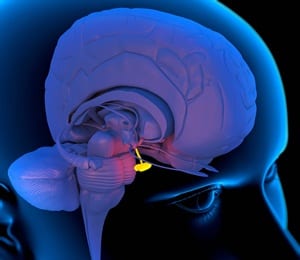Pituitary tumours or pituitary adenomas account for 15% of cerebral tumours. They are almost all benign tumours of the anterior (front) of the pituitary gland, which produces several important hormones that control other glands in the body, such as the thyroid, testes and ovaries.
The anterior pituitary gland produces the following hormones:
- Follicle Stimulating Hormone (FSH) – stimulates the ovaries to produce eggs but is also important in the male for fertility.
- Luteinizing Hormone (LH) – stimulates the ovaries to produce progesterone to help prepare the uterus for the reception of a fertilised egg.
- Adrenocorticotropic Hormone (ACTH) – stimulates the adrenal gland to produce cortisol and aldosterone, two very important hormones.
- Thyroid Stimulating Hormone (TSH) – stimulates the thyroid.
- Growth Hormone (GH) – stimulates the liver to produce ILF-1, which stimulates many cells in the body to grow.
- Prolactin (PRL) – is necessary for milk production in pregnant females.
The posterior pituitary gland produces two hormones:
- Anti Diuretic Hormone (ADH) – this hormone concentrates water in the kidney, preventing the kidneys from losing many litres of water per day.
- Oxytocin – this is important for the release of milk when a baby suckles the breast of its mother.
Pituitary tumours or pituitary adenomas account for 15% of cerebral tumours. They are almost all benign tumours of the anterior (front) of the pituitary gland, which produces several important hormones that control other glands in the body, such as the thyroid, testes and ovaries.
The anterior pituitary gland produces the following hormones:
- Follicle Stimulating Hormone (FSH) – stimulates the ovaries to produce eggs but is also important in the male for fertility.
- Luteinizing Hormone (LH) – stimulates the ovaries to produce progesterone to help prepare the uterus for the reception of a fertilised egg.
- Adrenocorticotropic Hormone (ACTH) – stimulates the adrenal gland to produce cortisol and aldosterone, two very important hormones.
- Thyroid Stimulating Hormone (TSH) – stimulates the thyroid.
- Growth Hormone (GH) – stimulates the liver to produce ILF-1, which stimulates many cells in the body to grow.
- Prolactin (PRL) – is necessary for milk production in pregnant females.
The posterior pituitary gland produces two hormones:
- Anti Diuretic Hormone (ADH) – this hormone concentrates water in the kidney, preventing the kidneys from losing many litres of water per day.
- Oxytocin – this is important for the release of milk when a baby suckles the breast of its mother.

Types of Pituitary Tumours
Broadly speaking, there are two types of pituitary tumours:
- Macroadenomas; which are tumours over one cubic centimetre.
- Microadenomas; which are less than one cubic centimetre.
Pituitary tumours can cause problems by growing too large and compressing adjacent structures, such as the optic nerves (which can cause blindness) or the nerves that control eye movement (which can cause double vision). Sometimes these tumours expand suddenly, causing headaches and a rapid onset of blindness.
Other pituitary tumours can secrete hormones, due to overproduction of these hormones. For example, a prolactinoma can lead to loss of periods, infertility or leakage of milk from the breast in women; or cause impotence in men.
Tumours that secrete growth hormone can cause acromegaly, where soft tissues in the body enlarge, such as the nose, tongue, fingers and heart. They can also cause other conditions such hypertension and diabetes. In children, excess growth hormone produces gigantism.
An over-secretion of ACTH can cause Cushing’s disease, where patients develop high blood pressure, depression, diabetes, osteoporosis and other problems.
On rare occasions pituitary tumours can secrete TSH, which can cause hyperactivity of the thyroid gland.
Some pituitary tumours can be treated with an endocrinologist or hormone specialist with medication. Other tumours, when they are large and compressing on adjacent structures or unresponsive to medical therapy, require surgery.
Surgery
If surgery is needed there are two approaches:

